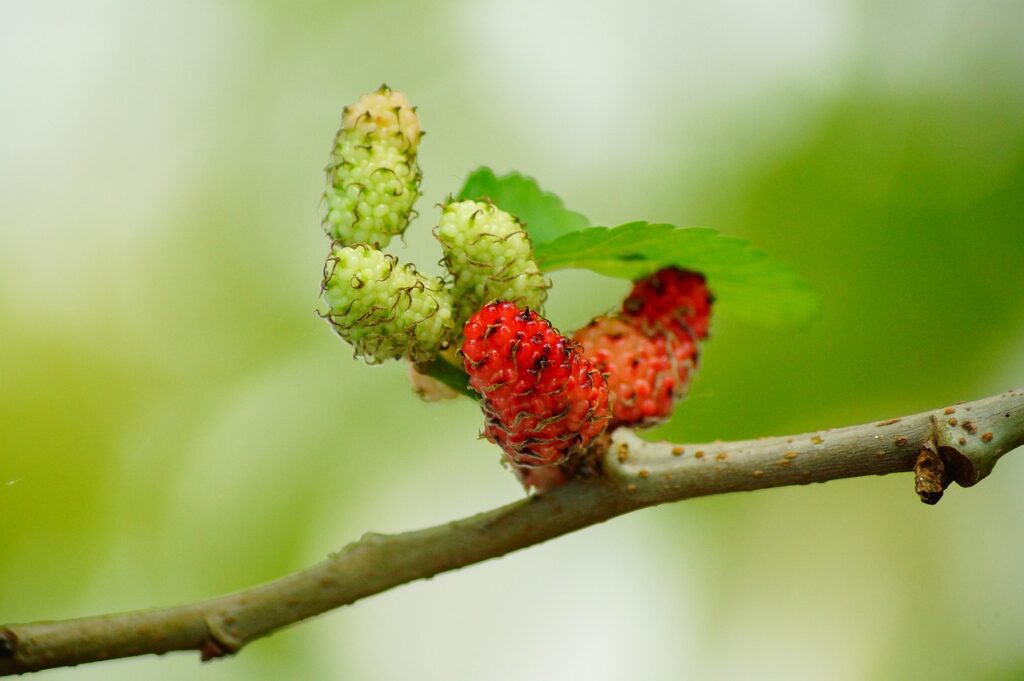Both white and red mulberries are sweet, juicy treats. They offer distinct characteristics beyond their color. We will discuss in detail about White vs Red Mulberry along with their health benefits and nutrition.
What is the difference between red and white mulberries?
Red and white mulberries are similar but have key differences in terms of appearance and nutrition. Here’s what makes them different from each other:
Red Mulberry:
Red mulberries have dull, dark green leaves with a rough, sandpapery texture on the underside. Their tree has a greyish bark with scaly ridges.
Red mulberries are generally larger (over 1 inch) and sweeter than white mulberries. They are almost always black when ripe and grow individually on the twig.
White Mulberry:
White mulberries have shiny, medium green leaves with a smooth underside. They have an orange-brown bark with deep furrows.
Their fruit can range in size from ¾ inch to larger. Their color can be white, red, or even deep purple when ripe (color varies more than red mulberries). They often grows in clusters on the twig. You can buy dried white mulberries from here.
White vs Red Mulberry Nutrition
The following table shows the difference in the nutritional profiles of white and red mulberry fruits.
| Nutrients | White Mulberry | Red Mulberry |
| Calories | 43 | 38 |
| Carbohydrates (g) | 10 | 9.8 |
| Fiber (g) | 1.7 | 1.7 |
| Protein (g) | 1.4 | 1.3 |
| Vitamin C (mg) | 33.6 | 36.4 |
| Potassium (mg) | 194 | 150 |
| Iron (mg) | 1.9 | 0.7 |
Red Mulberry and White Mulberry Benefits
Here are some benefits of white and red mulberries:
Blood Sugar Management
Mulberries have a role in blood sugar control. Studies suggest that mulberry leaves have a compound named, 1-deoxynojirimycin (DNJ), that mimics the effects of type-2 diabetes medications by slowing down the breakdown of carbohydrates in the gut, leading to suppression in blood sugar levels. This characteristic makes red and white mulberry leaves helpful for people with blood sugar concerns. You can consume leaves either in the form of powdered supplements or tea.

Cholesterol Lowering
Mulberries contribute to improved heart health by lowering cholesterol levels. Some studies in animals have shown a decrease in total and LDL (bad) cholesterol after consumption of white mulberry extract or tea.
Packed with Antioxidants
Mulberries are packed with antioxidants like vitamin C, flavonoids, phenolic acids, and alkaloids. These compounds help combat free radical damage in the body, which is linked to premature aging and various chronic diseases.
Regular consumption of mulberries contribute to overall cellular health and reduce the risk of many health conditions.
Potential Anti-Cancer Properties
Research suggests that white mulberries possess anti-cancer properties due to the presence of flavonoids and a higher-antioxidant profile. Studies conducted in labs have shown that flavonoids isolated from the fruit can inhibit the growth and spread of cancer cells in certain types of cancers, including breast, colon, and cervical cancers.
Strengthen Immune System
The presence of vitamin C and other antioxidants in mulberries strengthen your immune system. Vitamin C plays a crucial role in immune function by stimulating the production of white blood cells, which are essential for fighting infections.
It also acts as an antioxidant, protecting cells from damage caused by free radicals. Vitamin C enhances the absorption of iron, which is necessary for immune cell function.
White and red mulberries contain a variety of other antioxidants, including flavonoids, phenolic acids, and alkaloids. These compounds help combat oxidative stress in the body, which can weaken the immune system. By neutralizing harmful free radicals, these antioxidants contribute to overall cellular health and reduce the risk of infections and chronic diseases.
Have Anti-inflammatory Properties
White and red mulberries possess anti-inflammatory properties due to the presence of several key compounds. Both fruit and leaves are rich in various flavonoids, such as quercetin, kaempferol, and anthocyanins. These compounds have demonstrated anti-inflammatory effects.
They also have high levels of antioxidants like vitamin C, phenolic acids, and oxyresveratrol. These antioxidants neutralize free radicals, which can damage cells and contribute to inflammation.
White Mulberry Benefits for Skin
Both red and white mulberries offer several benefits for the skin. Bark of their tree is particularly rich in phenolic compounds that help regulate melanin production, the pigment responsible for skin color and hyperpigmentation (dark spots).
This fruit is a good source of vitamin C, which acts as a powerful antioxidant. Vitamin C helps neutralize free radicals that can damage skin cells and contribute to hyperpigmentation and signs of premature aging.
Side Effects of White Mulberry
White mulberries are generally considered safe for most individuals when consumed in moderation. There are some potential side effects to be aware of, such as:
- They can cause mild digestive discomfort, like bloating or gas, in some people.
- They have shown potential to lower blood sugar levels, so be cautious if you are already taking diabetes medications.
- Rarely, allergic reactions to white mulberries can occur, especially in individuals with allergies to birch pollen due to cross-reactivity. Symptoms may include: itching, hives, and swelling.
Conclusion
Both white and red mulberries offer a delightful and health-promoting addition to your diet. They offer benefits, including potential blood sugar management, cholesterol lowering, antioxidant power, and anti-inflammatory properties. Incorporating these berries into a balanced diet can contribute to overall well-being. You can order them online.
Red mulberries may offer a slight edge with their higher vitamin C content and potential eye health benefits. However, both varieties provide a unique nutritional profile and can be enjoyed for their delicious flavor and potential health perks.
FAQs
Black mulberry generally wins for flavor (sweetness + tartness), while white and red offer similar health benefits with white being more readily available.
Blackberries are generally considered healthier than mulberries due to their lower sugar content and higher fiber content.
No, mulberry and blackberry are distinct fruits. Mulberries grow on trees, while blackberries grow on thorny bushes. They belong to different plant families and have different flavors.
